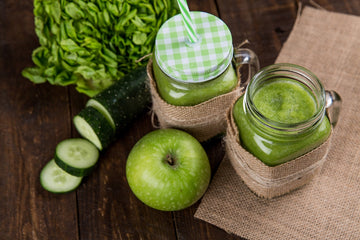Welcome to the world of green juices, Whether you love them or hate them, you can’t deny that green juices come with a lot of health benefits. Fruits and vegetables are an important part of a healthy and balanced diet, yet many people still find it hard to include enough of them in their daily routine.
Green juices are presented as a solution to this problem, as they provide an easy and convenient way to consume the necessary nutrients.
Processed foods are a significant part of many Individual’s diets. These foods are popular due to their ease, convenience, and affordability, making it challenging for people to resist buying them. Studies found that many individuals do not consume the recommended daily servings of fruits and vegetables. Instead, the Standard Diet contains excessive amounts of refined grains, added sugars, saturated fats, and sodium, which can have negative impacts on health.
So what can you do to include more essential nutrients in your diet? The answer is simple: green juices.

Green juices are usually made from nutrient-dense green vegetables like cucumber, spinach, kale and celery. Dark leafy greens, like spinach and kale, are high in vitamins A, C, K and minerals like calcium, iron, and potassium.
While green juices primarily consist of green vegetables, a small amount of fruit can be added to improve the taste, especially for those who may not enjoy the taste of certain vegetables like celery.
Citrus fruits and green apples as popular ingredients in green juices due to their high vitamin C content, which is beneficial for immune health. Additionally, ginger is another common addition to green juices due to its many wellness properties, including anti-inflammatory and digestive benefits.
Green juices are a healthy, delicious, and versatile snack that can be beneficial in starting or maintaining a healthy routine. By incorporating nutrient-dense vegetables and fruits, green juices can provide a quick and convenient way to boost the intake of vitamins, minerals, and antioxidants.

Difference between juices and smoothies?
Fresh juices and smoothies are two different types of drinks, even though they both can be nutritious.
Fresh juices are typically made by extracting the liquid from fruits and vegetables using a juicer. The juicing process removes the fiber from the product, leaving behind a concentrated liquid that is rich in vitamins, minerals, and antioxidants. Because fresh juices are made without fiber, they are usually lower in calories than smoothies, but they may not be as filling.
On the other hand, smoothies are made by blending whole fruits and vegetables together with other ingredients like yogurt, milk, or coconut water. Unlike juices, smoothies retain the fibre from fruits and vegetables, which can help keep you feeling full and satisfied. Smoothies can also be higher in calories than juices, depending on the ingredients used.
Overall, both fresh juices and smoothies can be a healthy addition to your diet, but it’s important to understand the differences between the two and choose the one that fits your nutritional needs and goals.

How many calories are in green juice?
A 350 ml serving of green juice made with mostly vegetables and a small amount of fruit can range from 50 to 150 calories. However, if your green juice contains more fruit or has added sweeteners like honey or agave, the calorie count may be higher. It’s important to read the labels carefully or calculate the calories yourself if you are trying to monitor your calorie intake.
The higher sugar content is also more likely to spike your blood sugar levels. Drinking green juice that has more vegetables than fruit juice might help to keep this in check.
You should also note that it matters where your juice comes from.
Store-bought juices may contain added sugars or preservatives that can increase their calorie count and lower their nutritional value. When making juice at home, you have more control over the ingredients and can ensure that you’re getting a fresher, more nutrient-dense product. Homemade juices also allow you to customize the ingredients to your taste and nutritional needs.
Additionally, the process of juicing can also impact the calorie count. Cold-pressed juices, for example, are made using a special juicing technique that minimizes heat and oxidation, which can help preserve the nutritional content and reduce the calorie count. So, if you’re concerned about the calorie content of your green juice, making it at home using a cold-pressed juicer and a mix of mostly vegetables and some low-sugar fruits can be a great option.

Is it okay to drink green juices on an empty stomach?
Starting your day with green juice can be a great way to give your body a boost of nutrients and energy. Green juices are typically made with a variety of fruits and vegetables, which are rich in vitamins, minerals, and antioxidants. These nutrients can help to support your immune system, boost your energy levels, and improve your overall health.
Drinking green juice in the morning can also help to kickstart your digestive system. The fiber and enzymes in fruits and vegetables can help to stimulate digestion and support a healthy gut. Some people also find that drinking green juice before breakfast can help to reduce cravings and support weight loss goals.
However, it’s important to remember that green juice should not replace a balanced breakfast or meal. While it can be a nutritious addition to your diet, it’s important to also include protein, healthy fats, and complex carbohydrates in your meals throughout the day to ensure that you’re getting all the nutrients your body needs.

Can I drink green juice every day?
Incorporating green juice into your regular routine is a great way to enjoy the nutritional benefits without committing to a full juice cleanse. You can easily make green juice at home using a variety of fruits and vegetables, or you can purchase it from a local juice bar or grocery store.
To keep things interesting, try experimenting with different green juice recipes and adding in different fruits, vegetables, and herbs. Some popular green juice ingredients include kale, spinach, cucumber, celery, ginger, and lemon. You can also add in fruits like apples, berries, or pineapple for a touch of sweetness.
Remember to always drink green juice as part of a balanced diet and lifestyle. While it can be a great source of nutrients, it should not replace whole fruits and vegetables, protein, healthy fats, and complex carbohydrates in your diet.

The Benefits of Green Juice:
1: Packed with antioxidants
Green juices can be packed with antioxidants! Antioxidants are compounds that can help to protect your cells from damage caused by harmful molecules called free radicals. Free radicals can be produced by environmental factors like pollution, radiation, and tobacco smoke, as well as by your own body’s metabolism.
Green juices can be a great source of antioxidants because they often contain a variety of fruits and vegetables that are rich in these compounds. Some examples of antioxidant-rich ingredients you might find in green juice include:
- Berries: Blueberries, raspberries, and blackberries are all high in antioxidants called anthocyanins.
- Leafy greens: Kale, spinach, and other leafy greens are rich in antioxidants like lutein and zeaxanthin.
- Citrus fruits: Oranges, lemons, and limes are all high in vitamin C, which is a powerful antioxidant.
- Carrots: Carrots are rich in beta-carotene, which is a type of antioxidant that your body can convert into vitamin A.
By drinking green juice regularly, you can help to boost your intake of these important antioxidants and protect your cells from damage.
2: Aids digestion
Fresh green juices can contain prebiotic compounds that support the growth of beneficial bacteria in the gut, which can help improve digestion and overall health. Prebiotics are types of dietary fiber that are not digested by our bodies, but instead, act as a food source for the beneficial bacteria in our gut.
By promoting the growth of good bacteria in the gut, prebiotics can help improve digestive function, support immune system health, and even promote healthy weight management. Some studies have also suggested that prebiotics may help to reduce inflammation in the gut, which is associated with a variety of health problems.
Green juices can be a great source of prebiotic fiber, especially if they contain ingredients like leafy greens, carrots, and other vegetables that are high in fiber. Drinking green juice regularly as part of a balanced diet can help promote a healthy gut microbiome and improve overall digestive health.
3: Immune boost
Green juices can be a great source of immune-supporting vitamins and minerals, including vitamins A, C, and E. Vitamin C, in particular, is known for its immune-boosting properties and is found in high amounts in many green juice ingredients, such as kale, spinach, and citrus fruits.
Ginger is another ingredient that can be added to green juice for immune support. Ginger contains anti-inflammatory compounds that may help support a healthy immune response. Additionally, it has been shown to have antimicrobial properties, which may help to fight off infections and support overall immune function.
Including green juice as part of a healthy and balanced diet can help to support overall immune function, especially when combined with other immune-supporting practices such as regular exercise, getting enough sleep, and minimizing stress.
4: Increased nutrient intake
Green juices can be a convenient way to get in a variety of nutrients from fruits and vegetables, especially for those who have busy lifestyles or struggle to consume enough produce through meals alone.
Additionally, juicing can be a helpful option for people who have trouble digesting whole fruits and vegetables or who have had surgery or other medical procedures that impact digestion. In these cases, consuming nutrients in liquid form can be easier on the digestive system and help ensure that the body is still receiving important vitamins and minerals.
However, it’s important to note that while green juices can be a great source of nutrition, they shouldn’t replace whole fruits and vegetables entirely. Whole foods contain fiber, which is an important nutrient for digestive health and can help regulate blood sugar levels. Therefore, it’s important to aim for a balance between whole fruits and vegetables and green juices in your diet.

What does green juice do for you? The bottom line on green juice benefits:
Juicing is a convenient way to increase your fruit and vegetable intake. Although the nutritional benefits are more or less the same as eating the fruit or vegetable whole, juicing offers a ton of health benefits.
- Juicing is a simple way to add essential nutrients and antioxidants to your diet
- They help you meet the daily recommended servings of fruits and vegetables
- Minimum prep time needed – juicing is a real time-saver for busy people
- If you aren’t a fan of many plant foods – juice is easy and quick to drink
- Easier to digest – this may benefit those who experience digestive problems
- They are a good base to add mix-ins like superfood powders













